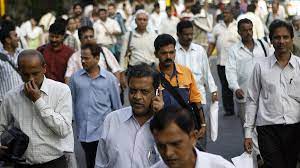Middle Class in India
Relevant for sociology optional Paper- 2 (Unit- 12 : Social Structure)

The middle class in India is a group of people who occupy a crucial position in the country’s socio-economic structure. The middle class is defined as the group of people who have a certain level of income, education, and lifestyle, which puts them between the upper and lower classes of society. The middle class in India is growing rapidly, and it is expected to play a significant role in the country’s development and progress.
The middle class in India is characterized by its diverse nature. It comprises people from various backgrounds, including professionals, businessmen, entrepreneurs, and government employees. The middle class is also geographically diverse, with a significant concentration in urban areas. The middle class in India is estimated to be around 250-300 million people, which is a considerable number considering the country’s population.
The middle class in India is defined by its aspirations and values. The middle class aspires to a certain lifestyle, which includes owning a house, a car, and other material possessions. The middle class also values education and knowledge, and it invests heavily in the education of its children. The middle class is also concerned about social status and is keen to maintain a certain image in society.
The middle class in India is also characterized by its political influence. The middle class is an active participant in the country’s political process and is vocal about its concerns and issues. The middle class is also a significant consumer of news and information, and it has access to various forms of media, including social media.
The growth of the middle class in India has significant implications for the country’s economy and society. The middle class is a significant contributor to the country’s economic growth, as it is a significant consumer of goods and services. The middle class is also a significant contributor to the country’s tax revenue, and it plays a crucial role in the country’s development.
The middle class in India also has significant social implications. The growth of the middle class has led to changes in the country’s social structure. The middle class is more progressive and open-minded than the traditional upper class, and it is more willing to accept social changes. The middle class is also a significant driver of social mobility, as it provides opportunities for people from lower classes to move up the socio-economic ladder.
However, the growth of the middle class in India has also led to some challenges. The growth of the middle class has led to a widening income gap between the middle and lower classes. The middle class has access to better education, healthcare, and other basic services, which the lower classes cannot afford. The growth of the middle class has also led to an increase in consumption, which has put pressure on the country’s natural resources and environment.
In conclusion, the middle class in India is a dynamic and diverse group of people who occupy a crucial position in the country’s socio-economic structure. The growth of the middle class has significant implications for the country’s economy and society. However, the growth of the middle class has also led to some challenges, and the government needs to take steps to address the issues of inequality and environmental degradation. Only then can we ensure that the growth of the middle class in India is sustainable and inclusive.
For more such free UPSC notes, Articles, News & Views Join our Telegram Channel. https://t.me/triumphias
Click the link below to see the details about the UPSC – Civils courses offered by Triumph IAS. https://triumphias.com/pages-all-courses.php


